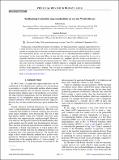Synthesizing Coulombic superconductivity in van der Waals bilayers
Author(s)
Fatemi, Valla; Ruhman, Yehonatan
DownloadPhysRevB.98.094517.pdf (943.2Kb)
PUBLISHER_POLICY
Publisher Policy
Article is made available in accordance with the publisher's policy and may be subject to US copyright law. Please refer to the publisher's site for terms of use.
Terms of use
Metadata
Show full item recordAbstract
Synthesizing a polarizable environment surrounding a low-dimensional metal to generate superconductivity is a simple theoretical idea that still awaits a convincing experimental realization. The challenging requirements are satisfied in a metallic bilayer when the ratio between the Fermi velocities is small and both metals have a similar, low carrier density. In this case, the slower electron gas acts as a retarded polarizable medium (a “dielectric” environment) for the faster metal. Here we show that this concept is naturally optimized for the case of an atomically thin bilayer consisting of a Dirac semimetal (e.g., graphene) placed in atomic-scale proximity to a doped semiconducting transition metal dichalcogenide (e.g., WSe[subscript 2]). The superconducting transition temperature that arises from the dynamically screened Coulomb repulsion is computed using the linearized Eliashberg equation. In the case of graphene on WSe[subscript 2], we find that T[subscript c] can exceed 100 mK, and it increases further when the Dirac valley degeneracy is reduced. Thus, we argue that suspended van der Waals bilayers are in a unique position to realize experimentally this long-anticipated theoretical concept.
Date issued
2018-09Department
Massachusetts Institute of Technology. Department of PhysicsJournal
Physical Review B
Publisher
American Physical Society
Citation
Fatemi, Valla and Jonathan Ruhman et al. "Synthesizing Coulombic superconductivity in van der Waals bilayers." Physical Review B 98, 9 (September 2018): 904517 © 2018 American Physical Society
Version: Final published version
ISSN
2469-9950
2469-9969